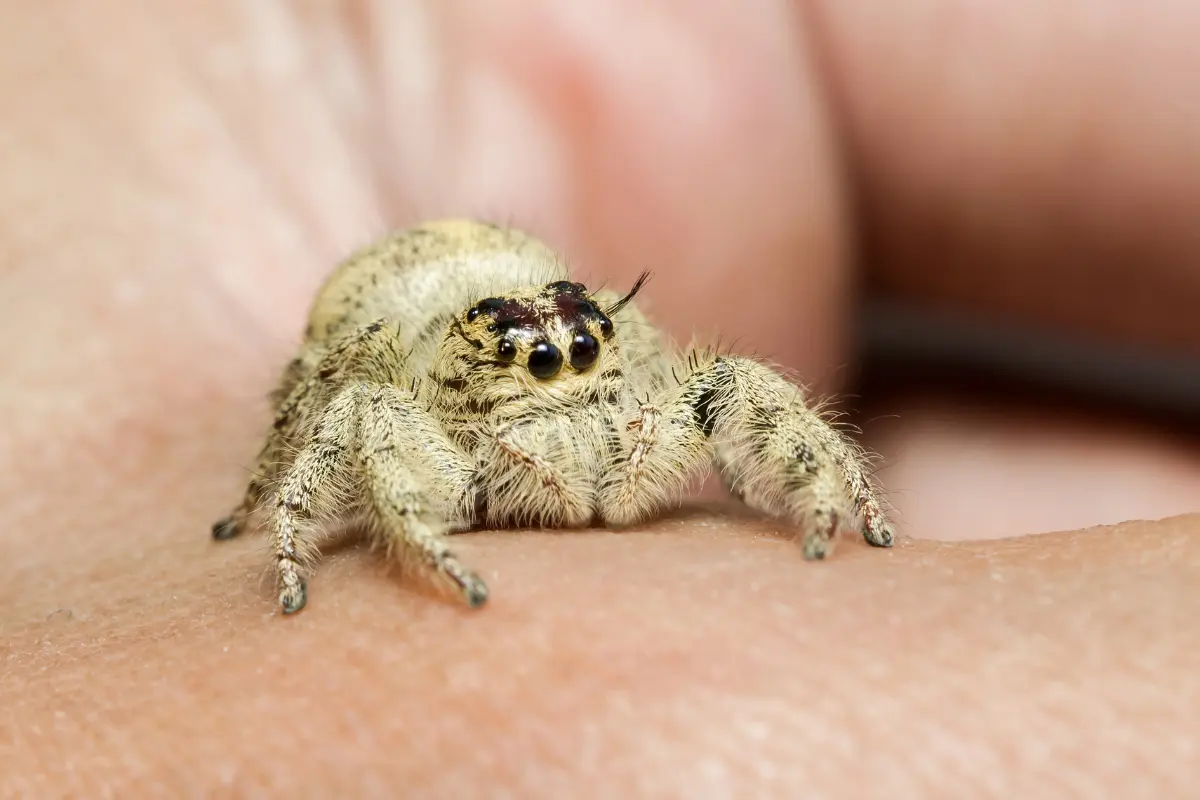How do jumping spiders see humans?

Jumping spiders have two primary, forward-facing eyes that offer high-resolution color vision, which is sharper than that of any other spider. Their sight is comparable to that of much larger animals, such as pigeons, cats, and elephants, and is even comparable to human vision. In fact, human vision is only about five to 10 times better than a jumping spider’s. These spiders can see in three color channels, which means they have trichromatic or “true” color vision, just like humans. Therefore, jumping spiders can see humans with their high-resolution colour vision, and they can distinguish between humans and other objects.
They also have four pairs of eyes that pick up on different visual cues, with the primary eyes being able to move their gaze and detect color and resolution.Jumping spiders can distinguish between animate and inanimate objects, including humans, and recognize the visual movements of living organisms. They have a near 360-degree view of the world and can be captivated by humans and nature videos.
Jumping Spiders’ Advanced Vision
- Jumping spiders have forward-facing eyes with high-resolution color vision comparable to some larger animals.
- They possess trichromatic vision like humans, perceiving three color channels.
- Four pairs of eyes enable them to detect various visual cues and movements.
- Jumping spiders differentiate between living beings and objects, including humans.
- Their nearly 360-degree field of view allows them to show interest in humans and nature videos.
- Their advanced color vision enables them to see and distinguish humans from other objects.
Can jumping spiders recognise individual humans?
There is evidence that jumping spiders can recognize individual humans. A study at the University of Lincoln showed they spent more time near and interacting with familiar humans. Another study found they can distinguish familiar individuals by facial features, even with a mask. However, researchers disagree on this ability, likely due to species differences and interaction contexts. Further research is needed to fully understand jumping spiders’ recognition abilities.
How do jumping spiders’ eyes differ from human eyes?
Jumping spiders’ eyes differ from human eyes in several ways:
- Eyes: Jumping spiders possess eight eyes, while humans have two.
- Eye Structure: Jumping spiders have primary eyes with fixed lenses and small, boomerang-shaped retinas that offer high-resolution color and UV vision. Human eyes are spherical, focusing light onto the retina at the back.
- Field of Vision: Jumping spiders enjoy almost 360-degree vision due to their eight eyes. Their primary eyes have fixed lenses and movable tubes, allowing scanning. Humans have binocular vision for depth perception.
- Color Vision: Jumping spiders share trichromatic color vision with humans, using three color channels for high-resolution color perception.
- Sensitivity to Movement: Jumping spiders discern animate and inanimate objects, including humans, through detecting and interpreting biological motion, perceiving living organisms by their movement.
- Face Attention: Jumping spiders are highly attentive to faces, recognizing when other jumping spiders or humans are looking at them. Their distinctive eye arrangement helps them identify when others are looking back.
How Jumping Spiders See Humans Conclusion
It’s important to note that jumping spiders are not capable of perceiving the world in the same way humans do. Their vision is adapted to their unique needs and behaviors. When a jumping spider “sees” a human, it’s likely interpreting the human’s movement, size, and possibly color. However, their perception might be quite different from how humans perceive other humans or their surroundings.
In summary, jumping spiders see humans through their advanced visual system, using their anterior median eyes to detect movement, assess distances, and potentially recognize color patterns. This remarkable visual acuity is a key factor in their hunting strategies and interactions with the world around them.
